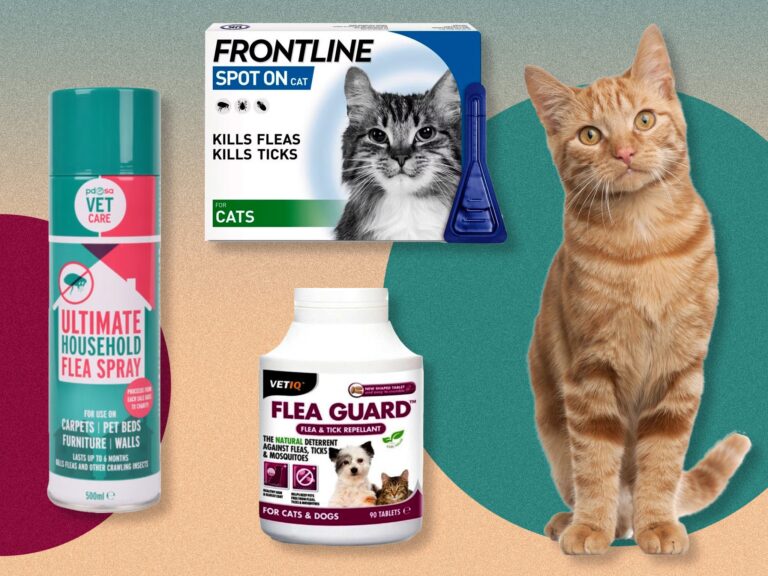You should generally wait at least two weeks before giving your dog another flea treatment to avoid the risk of over-treating your pet. It is important to read the product label carefully and follow the instructions for use to ensure the safety and effectiveness of the treatment.
When it comes to keeping our furry friends safe and healthy, it’s essential to stay on top of their flea prevention routine. However, many dog owners may wonder how soon they can give their dogs another flea treatment without compromising their pets’ well-being.
We will provide you with an accurate answer to this question while adhering to SEO-friendly guidelines. Understanding the appropriate timing for flea treatments can help ensure that your dog remains protected from these pesky parasites without any adverse effects. So, let’s delve into the topic and discover when it is safe to give your dog another flea treatment.

Credit: www.amazon.com
How Soon Can I Give My Dog Another Flea Treatment
When it comes to protecting our furry friends from fleas, it’s important to understand the proper timing for administering flea treatments. Giving your dog another flea treatment too soon can have consequences for their health and may even render the treatment ineffective. In this article, we’ll explore the recommended frequency of flea treatments, the dangers of over-treating your pet, and important guidelines for administering a second flea treatment.
Recommended Frequency Of Flea Treatments
The frequency at which you should give your dog a flea treatment largely depends on the product you’re using. It’s crucial to read the product label carefully and follow the instructions provided. In general, it is not recommended to administer flea treatments more frequently than once per month. Over-treating your pet can increase the risk of adverse reactions and may not provide any additional benefit in fighting fleas.
Dangers Of Over-treating Your Pet
Over-treating your dog with flea treatments can be hazardous to their health. Excessive use of these products can lead to various side effects such as skin irritation, itching, redness, and even chemical burns. Additionally, over-treating your pet can contribute to the development of resistance in fleas, rendering the treatment ineffective over time. It’s important to strike a balance and adhere to the recommended guidelines to ensure the safety and efficacy of the flea treatment.
Guidelines For Administering A Second Flea Treatment
If your dog still has fleas or if the initial flea treatment didn’t work as expected, you might be considering giving a second treatment. However, there are important guidelines to follow to avoid any potential risks. It’s essential to wait for the old medication to wear off before applying a new flea treatment. Even if the previous treatment is no longer effective, dosing your dog with a new medication too soon can lead to accidental overdose. Therefore, it’s crucial to wait for the recommended waiting period, typically four weeks, before administering a second treatment.
Remember, the health and well-being of your furry friend should always be a top priority. By adhering to the recommended frequency of flea treatments, understanding the dangers of over-treating, and following the guidelines for administering a second treatment, you can ensure the effective protection of your dog against pesky fleas.

Credit: www.adamspetcare.com
Reasons For Changing A Flea Medicine
Changing a flea medicine for your dog should be done carefully. It is generally not recommended to administer flea treatments more frequently than once per month, as this can increase the risk of over-treating your pet. Always read the product label and follow instructions for use.
Identifying The Right Flea Treatment
Choosing the right flea treatment for your dog is crucial to effectively combatting flea infestations.
When it comes to flea medicines, it’s important to understand that not all treatments are created equal. Some products may work better for certain dogs, while others may be more suitable for specific environments or types of infestations.
Identifying the right flea treatment starts with consulting your veterinarian. They can assess your dog’s health, lifestyle, and any existing medical conditions to recommend the most appropriate product.
Consider the following factors when selecting a flea medicine for your dog:
- Your dog’s weight and age
- The severity of the flea infestation
- Possible allergies or sensitivities
- The presence of other parasites, such as ticks or worms
By taking these factors into account, you can make an informed decision and choose a flea treatment that is safe and effective for your furry friend.
Possible Resistance To Medication
It is important to be aware that fleas can develop resistance to certain medications over time. This means that a treatment that once worked effectively for your dog may no longer be as effective in eliminating fleas.
If you notice that your current flea medicine is no longer providing the desired results, it may be time to consider switching to a different product. This is particularly important in the case of recurring flea infestations, as continuing to use the same treatment may simply perpetuate the problem.
When switching flea medications, it’s crucial to follow the instructions provided by your veterinarian or on the product label. Avoid overlapping treatments or administering multiple medications simultaneously, as this can increase the risk of adverse reactions or overdosing.
Flea Infestation In The Home Or Yard
In some cases, changing flea medication may be necessary to address a larger issue like a flea infestation in your home or yard.
If you have tried multiple treatments, but the fleas continue to persist, it may indicate that the infestation is not limited to your pet alone. Fleas can easily infest the environment, laying eggs in carpets, bedding, and outdoor areas.
In such circumstances, it is important to not only treat your dog but also take proactive steps to eliminate fleas from your home and yard. This may involve thorough cleaning, vacuuming, washing bedding, and treating outdoor areas.
Changing your dog’s flea medication can be part of a comprehensive approach to combatting fleas, ensuring that you are targeting both your pet and their environment.
Tips For Effective Flea Treatment
When it comes to giving your dog another flea treatment, it is generally recommended to wait at least two weeks before reapplying. This allows enough time for the previous treatment to wear off and reduces the risk of over-treating your pet.
Always read the product instructions carefully to ensure proper usage.
Consulting With A Veterinarian
Before starting any flea treatment regimen for your dog, it is highly recommended to consult with a veterinarian. They are experts in animal health and can provide guidance specific to your dog’s needs. A veterinarian will assess your dog’s overall health, any existing medical conditions, and recommend the most suitable flea treatment option.
Proper Application Techniques
When applying flea treatment to your dog, it is important to follow the proper application techniques. Each flea treatment product will have specific instructions on how to apply it. Some common tips for proper application include:
- Ensure that your dog is calm and relaxed before applying the treatment.
- Part the fur and apply the product directly onto the skin, usually between the shoulder blades or at the base of the neck.
- Avoid applying the treatment near the eyes, mouth, or any open wounds.
- Do not massage or rub the product into the skin, as it needs to spread naturally.
- Wash your hands thoroughly after applying the treatment.
- Follow any additional instructions provided by the product manufacturer.
Treating Multiple Animals
If you have multiple animals in your household that require flea treatment, it is important to treat each animal individually. This will help prevent the fleas from spreading between animals and ensure effective treatment. Some tips for treating multiple animals include:
- Consult with a veterinarian to determine the most suitable flea treatment for each animal.
- Administer each treatment according to the recommended dosage and application instructions.
- Keep the animals separated for a short period after application to prevent them from licking off the treatment or transferring it to each other.
- Regularly monitor all animals for any signs of flea infestation or reinfestation and consult with veterinarians if needed.
By consulting with a veterinarian, following proper application techniques, and treating each animal individually, you can ensure the effectiveness of flea treatment for your dogs. Remember to read and follow the product label carefully to ensure the safety and well-being of your pets.

Credit: www.amazon.com
Frequently Asked Questions Of How Soon Can I Give My Dog Another Flea Treatment
How Soon Can I Reapply Flea Treatment To My Dog?
You shouldn’t reapply flea treatment to your dog more than once per month to avoid over-treating them. It is important to follow the product label instructions and consult with your veterinarian if needed. If the initial treatment doesn’t work, wait at least four weeks before applying another treatment to prevent overdose.
It’s crucial to ensure the previous medication has worn off before administering a new one to avoid accidental overdose.
Can I Give My Dog Two Flea Treatments In A Month?
Yes, you can give your dog two flea treatments in a month, but it is important to follow the product label instructions and not exceed the recommended frequency. Over-treating your pet can be harmful. Make sure the old treatment has worn off before applying a new one to avoid accidental overdose.
How Far Apart Do Flea Treatments Need To Be?
Flea treatments need to be applied once per month, with a waiting period of four weeks between each application. Applying treatments more frequently can be harmful and may lead to an overdose. It’s important to follow the product label instructions and not reapply before the recommended time.
Can I Give My Dog A Second Flea Treatment?
Yes, you can give your dog a second flea treatment. However, it is important to wait for the old medication to wear off before administering a new one. Giving a new treatment too soon may cause an accidental overdose. Please consult with your veterinarian for proper guidance.
Conclusion
O be vigilant about keeping your pet’s environment clean and regularly treat for fleas. Third, it’s possible that your dog is being exposed to fleas from other animals or outdoor areas. In any case, it’s important to consult with your veterinarian to determine the best course of action for your dog’s specific situation.
Remember, always read and follow the instructions on the flea treatment product carefully to ensure the safety and effectiveness of the treatment.



